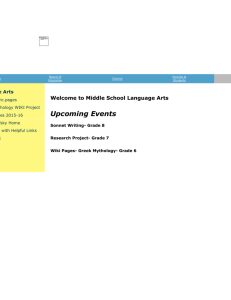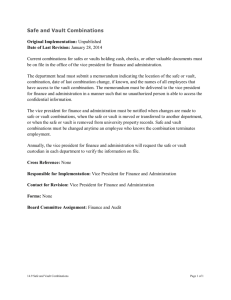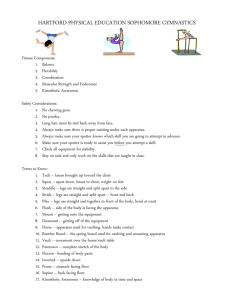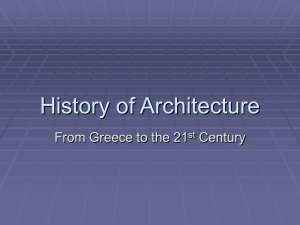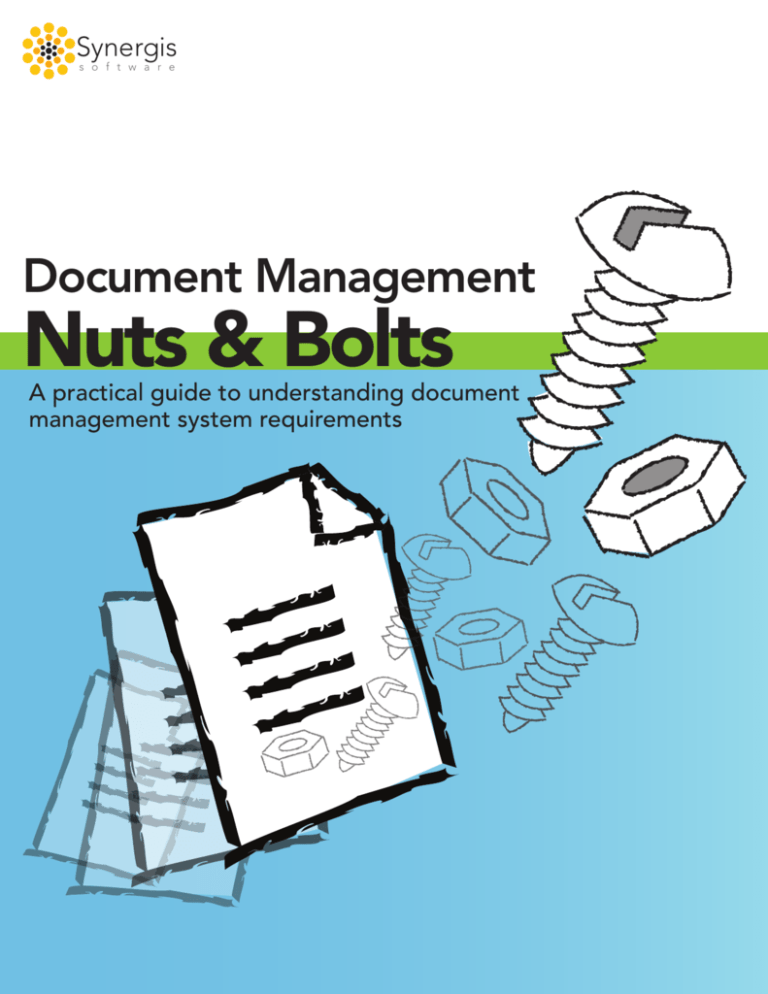
Synergis
s o f t w a r e
Document Management
Nuts & Bolts
A practical guide to understanding document
management system requirements
Document Management Nuts & Bolts
Contents
Part 1: Client Software Requirements
How your users will interact with and be accommodated by a document
management system.
Part 2: Application Server Software
The brains of the document management system you install on the server and
different ways to distribute the components.
Part 3: Vaulting
How documents get in and out of the document management system—and
stay secure.
Part 4: System Hardware Requirements & Considerations
Make the most of your existing hardware and things to consider when
investing in new hardware.
Part 5: Optimizing Performance
Be aware of factors that can positively affect or negatively impact the
performance of your document management system.
Synergis
s o f t w a r e
200 Kelly Road · Quakertown, PA 18951 800.836.5440 / 215.529.9900 www.SynergisSoftware.com
Document Management Nuts & Bolts
About the Author
Todd Cummings is the Vice President of Research and
Development for Synergis Software, the developer of
Adept Engineering Document Management software.
Todd has directed R&D at Synergis Software for over 14
years and is passionate about the benefits of document
management for solving the most pressing business
challenges for engineering companies. Todd is an expert
in all areas of document management including: Needs
analysis and ROI; hands-on troubleshooting and problem solving; managing
implementation projects; designing and writing product requirements; and
communicating complex ideas in a easy-to-understand manner to all levels of
customers. Todd has been a guest speaker at Autodesk University, SolidWorks
World, ASME, TAPPI, and the United State Coast Guard CADD and GIS
Symposium and has also given hundreds of technical presentations to SMBs
and Fortune 100 companies.
Synergis
s o f t w a r e
200 Kelly Road · Quakertown, PA 18951 800.836.5440 / 215.529.9900 www.SynergisSoftware.com
Document Management Nuts & Bolts
Introduction
This white paper intends to help business and high-level technical
evaluators understand the breadth and scope of the components that
make up an engineering document management system—whether it’s on
a LAN, a WAN, or the Internet.
Because engineering document management is a mission critical
application that touches many people in an organization, it’s my goal
to give you a solid foundation in the high-level technical requirements
and business considerations of a document management system as early
as possible in your research/evaluation process. That way you are 1)
better prepared to do a great job asking questions and comparing vendor
products; and 2) you are on track for a truly successful implementation,
knowing how all the pieces of the puzzle fit together.
Whether you are team of one or many, whose job it is to understand all
the interacting parts of a document management system, this paper is
a must read. For those of you who are new to document management,
this material will help you connect your business knowledge with the
technical requirements and give you the vocabulary you need for further
exploration.
So, let’s get started!
Synergis
s o f t w a r e
200 Kelly Road · Quakertown, PA 18951 800.836.5440 / 215.529.9900 www.SynergisSoftware.com
Document Management Nuts & Bolts
Part: 1
Part 1: Client Software Requirements
Client software requirements define how users interact with the system.
Data Creators vs. Data Consumers
To understand fully the ways users interact with a document management
system, we need to appreciate the differences between data creators and data
consumers. When it comes to client requirements, you’ll need to consider both
groups.
In a design engineering-centric world, data creators are those users who work
inside the CAD applications. They create and revise existing CAD documents.
In today’s global organizations, data creators are certainly designers and can
be engineers or project leads responsible for specifications, analysis, or project
and product success. Creators contribute data and documents to the system.
They are also your power users and require a more powerful workstation.
Data consumers are the people that need to work with the data submitted
by the data creators. Data consumers have different needs and often access
the system using a different interface than the data creators. Generally, data
consumers access the system to view, print or redline via a streamlined user
interface and then, often only part time.
Most document management deployments are accomplished using more
than one type of client. It’s rare that a company deploys just one type of user
interface to access the system. So let’s look at some of the different client
deployment methodologies.
Client Workstation Deployment
The first client we’ll discuss is the client that is
installed on a local workstation. It is a classic
install where the actual program files – such as
Word or Excel or Outlook – are installed on each
individual’s workstation, as seen in the figure to
the right.
Synergis
s o f t w a r e
200 Kelly Road · Quakertown, PA 18951 800.836.5440 / 215.529.9900 www.SynergisSoftware.com
Document Management Nuts & Bolts
Part: 1
Network Client Deployment
A network client deployment is where the
document management client is installed on the
server in one location. Users in this method use
a desktop shortcut to launch the application (see
figure on right).
Generally, IT appreciates this lightweight
deployment because they can install the application
in one location and serve updates out to everyone
easily. The trade-off is that user performance might
take a hit. It’s also important to keep in mind not all
document management systems support a network
deployment well.
Client Browser Deployment
For many companies today, it’s becoming more
important to deploy a client through a browser
(see figure on right). Browser access can mean
access via the Internet but many also deploy a
browser client behind the firewall.
These deployments are relatively thin and from
an IT perspective should be close to no-touch.
For example, if a person can open a browser and
point to a URL and the application of the data
housed in it is immediately available.
Remote Client Options
A remote client deployment is yet another option. This entails Citrix, terminal
services, or similar technologies, which are popular, centralized methods for
IT to deploy access to a document management system. The important thing
to understand when using this method is that not all document management
systems are friendly to this environment. This method may also require
that the CAD applications are deployed on the central server and not all
CAD applications support this. So it’s necessary to identify up front if this
is a requirement for your organization and whether your chosen document
management system supports it.
Synergis
s o f t w a r e
200 Kelly Road · Quakertown, PA 18951 800.836.5440 / 215.529.9900 www.SynergisSoftware.com
Document Management Nuts & Bolts
Part: 2
Part 2: Application Server Software
In the last section, I discussed the nuts and bolts of a document management
solution as it relates to client workstation deployment. In this section, I’ll
talk about the server-side components, application server software, and the
database engine components of the system.
Application Server Software
The application server software is the silent piece of the document
management system that users don’t see—but IT does. It’s the brains of the
document management solution installed on the server.
You can think of the application server software as an information broker. It’s
what every user connects to and it facilitates data exchange between each user,
the database, and the document vaults.
There are a couple of ways you can deploy
the application server software. The figure
on the right illustrates a deployment where
all the server side components are installed
on one server, including the application
server software, the vault server software,
and the database engine.
The figure below illustrates another type
of deployment where the application
server software is installed on a different server than the database engine.
Flexible and scalable document management systems support this modular
deployment strategy.
Synergis
s o f t w a r e
200 Kelly Road · Quakertown, PA 18951 800.836.5440 / 215.529.9900 www.SynergisSoftware.com
Document Management Nuts & Bolts
Part: 2
In fact, often there are more server side components, which may be distributed
across multiple servers. Architectural flexibility in this regard is solution
dependent. In small-to medium-size deployments, I like to recommend
keeping all the application server software components on one server if
possible. In larger organizations where user and document counts are higher,
multiple servers may be required.
When the database and the application server software are on different
servers, make sure you have at least a gigabit ethernet connection between
them. Otherwise, you are likely to encounter a performance bottleneck.
The Database Engine
There are three different categories of database engines that document
management systems support: Well-known name brands like Microsoft
SQL Server and Oracle; less familiar, yet commercially available databases;
and proprietary databases developed and supported by the document
management vendor.
I am often asked, “Which database is best?” In my mind, the most important
question is not “Which database is best” rather, “Which database will best
meet my company’s business needs?” If your company has a database
standard that IT supports, then the decision is made. If your company has no
mandated database engine, then you’ll need to select one.
If you’re a small company without consistent access to database experts,
I don’t recommend choosing a “high-end” database solution for your
implementation. If you do have DBA expertise in house, then a “high end”
solution could be a good choice.
Beyond the basic criteria of price, performance and scalability, the main driver
in today’s interconnected business environment is access to your data—
whether it be through open database connectivity protocols like ODBC or
vendor-provided APIs. You also want the document management systems’
schema to be open and accessible. Your data is your most critical knowledge
asset—so make sure you can access it.
As a final thought, I encourage you to understand database engine licensing
requirements, as they can be difficult to decipher. Most database vendors
Synergis
s o f t w a r e
200 Kelly Road · Quakertown, PA 18951 800.836.5440 / 215.529.9900 www.SynergisSoftware.com
Document Management Nuts & Bolts
Part: 2
offer varied licensing options that can make a significant difference in your
company’s overall investment. Take time to fully understand the options
before making your final selection. In many cases, database licensing is
un-metered and compliancy depends on your understanding of the licensing
requirements and the honor system.
Synergis
s o f t w a r e
200 Kelly Road · Quakertown, PA 18951 800.836.5440 / 215.529.9900 www.SynergisSoftware.com
Document Management Nuts & Bolts
Part: 3
Part 3: Vaulting
Now we arrive at another critical document management component, the
vault. Although it is also a server side component, it deserves discussion on
its own. In everyday language, a “vault” conjures images of a steel-reinforced
concrete room where banks store their cash. Ideally, your corporate electronic
assets, the documents, are protected from unauthorized user access and
secure. Vaulting, however, also explains how documents are moved in and out
of that specified ‘vaulted’ location. Simply stated, vaulting manages the way
documents get in and out of the document management system as well as
where and how they are stored, protected, and secured.
Common Types of Vaults
Often, I am asked, “Which type of vault is best?” I believe the answer is selfevident once you truly understand the type of vaulting mechanism used by
your document management system of choice. Once you understand this, you
will be answering the question “Which type of vaulting mechanism is best for
my company?”
A wraparound vault literally wraps around your existing file structure
without changing the folder or file names it enfolds. It also secures all content
from unauthorized “back door” access through Windows Explorer. Many
companies prefer this type of vault because it doesn’t scramble file names or
move file locations, which makes it easy to access and recover documents in
human readable format in the event of a network failure. This type of fault
tolerance is often popular with technology and business owners alike.
A proprietary or a scrambled vault copies the documents from your existing
folder structure and moves them to a new location. This method of vaulting
documents also scrambles or hashes the original filename, and more often
than not, the folder names. Scrambling or hashing a file name or location is
not the same as file encryption. When data is encrypted, an algorithm is used
to make it unreadable to the user and to its editing application – until a file is
decrypted.
Here’s an example. When you place the file “my-document.doc” into a
proprietary vault, that document is given a different name. It is not encrypted,
but rather the name and the folder in which it resides is named something
that a user won’t easily recognize, for instance “PQ_123.ZFW”. The same goes
Synergis
s o f t w a r e
200 Kelly Road · Quakertown, PA 18951 800.836.5440 / 215.529.9900 www.SynergisSoftware.com
Document Management Nuts & Bolts
Part: 3
for file folders. In a proprietary or scrambled vault, the original folder name,
let’s say, “Acme Corporation” will be moved into a folder with a name that is
undecipherable to the user.
An overlay vault sits on top of an existing file structure, but provides passive
security—meaning it doesn’t really protect documents from “back door”
Windows Explorer access.
A blob vault places documents into the document management database in
fields, within the database schema. In this way, a blob vault can grow your
database exponentially and cause database backups to take significantly
longer.
With any of these vault types, the size of the vaulted data, meaning the actual
number of documents and their cumulative size in gigabytes, or these days
even terabytes—is important to keep in mind. If you are managing 100K Word
files, then a solution using a blob vault may be appropriate for your needs.
However, if you have large numbers of CAD documents that are hundreds
of megabytes or gigabytes in size, then the blob vault could hinder system
performance.
Vault Attributes
All these vault types can have different attributes, which modify or enhance
their usefulness in your organization. Common vault attributes are multiple
or remote vaults; hybrid vaults; and replicated/synchronized vaults.
A multiple or remote vault system can accommodate multiple document
stores across multiple servers in different geographic locations.
A hybrid vault gives some users access to documents through Windows
Explorer (e.g., in a read-only mode) while others have limited or no access,
except through the document management system.
A replicated/synchronized vault duplicates documents in remote locations
and keeps document revisions synchronized across all locations. This attribute
can eliminate the on demand need to transfer large amounts of data across the
WAN during peak usage times.
Synergis
s o f t w a r e
200 Kelly Road · Quakertown, PA 18951 800.836.5440 / 215.529.9900 www.SynergisSoftware.com
Document Management Nuts & Bolts
Part: 3
And the Best Vault is…
As we discussed earlier, the most relevant question for you is, “What’s the
best vault for my company?” Now that you understand different common
approaches to document management vaulting methodologies, you may use
these questions to help you further clarify the solution that is best for you:
• Which vaulting method best matches your company’s business goals
and its technology requirements?
• What are your backup strategies?
• What are the replication strategies for each type of vault?
• What are your company’s uptime requirements and fault tolerance
plans?
Keep these criteria in mind as well:
•
•
•
•
•
•
Speed/document access
Administrative/IT overhead
Additional system resources/requirements
Document transport methodologies
Company security policies
Ease of maintenance
Ultimately, the best vaulting method and attributes will depend on your
specific environment.
Synergis
s o f t w a r e
200 Kelly Road · Quakertown, PA 18951 800.836.5440 / 215.529.9900 www.SynergisSoftware.com
Document Management Nuts & Bolts
Part: 4
Part 4: System Hardware Requirements &
Considerations
Getting the Hardware Right
Now that we have discussed the different high-level aspects of a document
management system—it’s time to tie these concepts together and consider
the hardware required to meet your business and deployment goals. The
hardware you need to support your document management implementation
will depend on several variables:
• Are your users in one location or distributed across multiple geographies?
• Does your company have a standard, approved database technology?
Are there existing database instances already housed on servers that your
document management system must utilize?
• Does the document management system have specific standard or
nonstandard hardware requirements—whether it be on a LAN, across the
WAN, or even the Internet?
• Do you have business justification to dedicate hardware to your document
management system?
• Does the system support, and are there benefits to distributing server
components across multiple pieces of hardware?
• Does your company currently have a server virtualization initiative
underway; and does your chosen document management solution support
virtual servers in production?
Once you answer these questions, you’ll be able to determine the hardware
requirements that are the best profile for your document management
implementation. In truth there is really no “one size fits all” hardware
solution. Hardware requirements also depend on the number of locations and
people you want to support.
Remember that minimum requirements for a test bed or a sandbox
implementation are probably not sufficient for a full production environment.
Synergis
s o f t w a r e
200 Kelly Road · Quakertown, PA 18951 800.836.5440 / 215.529.9900 www.SynergisSoftware.com
Document Management Nuts & Bolts
Part: 4
I remember several years ago when the minimum requirements for SQL
Server were published. At that time, a Pentium 3 with a minimum of 256
MB of RAM was recommended as a minimum. Even then, no IT department
would have ever deployed an enterprise application using those guidelines.
On the other hand, there may be diminishing returns on over specifying your
hardware. Be sure to discuss the requirements that will best serve the solution
and your successful deployment. Your document management provider will
be well versed in properly specifying hardware.
Most document management server side components and database engines
are multi-threaded applications; they will take advantage of multiple
processes and multi-core processors. This in turn, increases server side
application performance and therefore the overall end user application
response time. Because RAM is relatively inexpensive, you don’t need to cut
corners there. In fact, with the wider adoption of 64-bit operating systems,
more RAM can be used efficiently than in 32-bit server operating systems.
It’s best to work with your document management provider to determine the
optimal amount of RAM.
As you appreciate, when specifying the right hardware for your solution,
details can be important. One overlooked area is in the communication
between the application server software and the database engine.
Typically, it’s a rapid-fire communication, so it makes the best sense to
invest in a quality, high-speed interface card between the motherboard
and the hard drive to get the highest possible response time and the best
overall performance. This looks beyond RAID strategy to the actual hard
disk controller itself. A little extra here can make a difference in overall
performance.
If you use virtual server technology, the recommended hardware-based server
resources may be different from those recommended for standalone hardware
servers. Here’s a simple rule of thumb: if the document management system
requirements say you need an application server with two gigabytes of
RAM, you’ll generally want to specify slightly more RAM in a virtual server
environment. While folks who live deep inside virtual server technology
might not agree, field experience says you’ll need more RAM.
Synergis
s o f t w a r e
200 Kelly Road · Quakertown, PA 18951 800.836.5440 / 215.529.9900 www.SynergisSoftware.com
Document Management Nuts & Bolts
Part: 4
Perhaps the single, most important part of any discussion regarding the
hardware requirements and planning is this: Be sure you have a backup
solution in place and be sure to validate that it’s working as intended.
Although this may seem like common sense, the results of a failed backup
strategy are both heartbreaking and costly to your business.
Vault Hardware Requirements
Vault server software isn’t usually resource intensive enough that you will
require a separate piece of hardware. That’s not to say that you should ignore
the vaulting hardware requirements entirely. Rather, note that additional
hardware to support a vault is uncommon.
If you have multiple vaults across different geographic locations, it’s best to
have vault server software at each remote site. You will have one instance
of the application server/business logic component of your document
management solution at your company’s main location, but you may have
multiple instances of the vaulting software deployed across different pieces
of hardware in your organization. If you require replication, you may need to
invest in a dedicated piece of hardware--but that’s not always the case. Your
company’s requirements coupled with the vault methodology you choose will
ultimately dictate the hardware you require.
Deploying Hardware
Here are some variations on hardware deployments to consider. These
diagrams do not illustrate all the variations that we see in the field; however,
they should provide good examples of some common deployments.
The figure to the right is a keep-it-simple
deployment where everything for your
document management deployment fits on a
single piece of hardware.
Synergis
s o f t w a r e
200 Kelly Road · Quakertown, PA 18951 800.836.5440 / 215.529.9900 www.SynergisSoftware.com
Document Management Nuts & Bolts
Part: 4
The figure below shows a deployment on a LAN. You have a central database,
an application server, and a remote vault. When remote users need accesses
to a document, it comes from a remote vault. In this particular example, the
system is not accessible outside the firewall.
The figure shown on the right is
another very common deployment
where there are local area and
wide area users as well as users
accessing the system outside the
firewall.
Synergis
s o f t w a r e
200 Kelly Road · Quakertown, PA 18951 800.836.5440 / 215.529.9900 www.SynergisSoftware.com
Document Management Nuts & Bolts
Part: 4
On a grander scale, the figure below shows a global implementation with
multiple remote vaults and multiple users around the world accessing the
system. As you might imagine with multiple locations across the world, users
access the system 24/7. Not only do design teams across different time zones
access the central database, they also access documents from remote vaults all
over the globe. This is becoming a very popular methodology as companies
collaborate and grow internationally.
200 Kelly Road · Quakertown, PA 18951 800.836.5440 / 215.529.9900 www.SynergisSoftware.com
Document Management Nuts & Bolts
Part: 5
Part 5: Optimizing Performance
Since the success of your document management system relies on your
network infrastructure, next we’ll focus on some key areas for you to be aware
of as you finalize your plans.
It’s important to make sure your network backbone isn’t the weak link that
causes poor performance and consequently a bad user experience. By today’s
standards, most deployments over a local area network environment perform
well. Performance challenges tend to arise in extended Wide Area and Internet
deployments. The factors that have the most impact in these environments
are bandwidth, latency, and the way your document management system is
optimized for both.
Bandwidth
Bandwidth is the maximum amount of data that can travel over a
communications path in a given amount of time. It’s measured in bits per
second. A T1 line, for example, is 1.544 kilobits per second. Bandwidth is
really all about measuring potential, not unlike the amount of electricity
that can travel over a particular wire. When we talk about having a certain
amount of bandwidth, like a T1, the common term refers to the maximum
amount available. The tricky thing is that the maximum available bandwidth
can diminish rapidly. If there’s a lot of data being transferred over a fixed
amount of bandwidth, the available or effective bandwidth is reduced.
Additionally, a T1 in one company may have consistent adequate bandwidth
while a T1 in another company may have less effective available bandwidth,
e.g., a company with 25 employees vs. a company with 100 employees. With
an additional 75 employees using the available bandwidth, the effective
bandwidth will be less.
Most IT departments today have a very good handle on available and
effective bandwidth. Greater challenges exist when connectivity is required
between the US or Europe and emerging countries. In this situation, available
bandwidth can vary dramatically.
Latency
Latency, or the measured time between data transmission and arrival across
a network, is the hidden performance killer on a WAN. You might have
adequate bandwidth but very slow data access times because latency is high.
Synergis
s o f t w a r e
200 Kelly Road · Quakertown, PA 18951 800.836.5440 / 215.529.9900 www.SynergisSoftware.com
Document Management Nuts & Bolts
Part: 5
Latency is measured in milliseconds. On today’s LANs, the average access
time between a workstation and the server is probably less than 1 millisecond.
On a good performing WAN, it’s in the 25 to 40 millisecond range. Across the
Internet, latency can be 100 milliseconds or more depending on the path the
data signal takes.
Reducing Latency
When it comes to dealing with latency there are good tools that monitor a
network and help you define strategies to reduce the amount of lag time
between transmission and arrival of data across the wire. “Chatty” or verbose
applications can increase general latency and therefore, can negatively affect
other applications.
If you have an inadequate bandwidth situation, then you certainly can
increase the bandwidth. For instance, if you have a T1 you can introduce a
T3. In some, but not all situations, increasing bandwidth will also reduce
latency. You might also try to reduce the number of “hops” between locations
or compress the data footprint that is being transmitted. The wide area
acceleration market in the IT field is booming today and there are some very
good technologies to help increase performance over the wide area network
by directly reducing latency.
Poor application response in a wide area deployment could also be due to the
way your document management system processes information. It could be
that your document management system is not optimized for communication
across lower bandwidth or higher latency environments.
Multiple Remote Vaults
Another way to improve performance in your document management system
is to use remote vaults. With this methodology, you put the documents in a
vault where they are most commonly accessed so that you reduce the amount
of information that gets transferred across the wire.
You can also replicate vaults. If you have teams of people around the country
who require access to most of the documents or even specific projects you are
tracking and managing, then it is possible to replicate them so that everyone
has immediate access to the data and nobody has to pull large amounts of
documents across the wide area network.
Synergis
s o f t w a r e
200 Kelly Road · Quakertown, PA 18951 800.836.5440 / 215.529.9900 www.SynergisSoftware.com
Document Management Nuts & Bolts
Part: 5
Many variables contribute to optimum performance. Depending on the scope,
business goals, and mandates of your document management initiative, it
pays to consider them in advance. For example, a client called me and shared
that their business team required IT to make connectivity over the WAN
between the US, Europe and China perform as if all users, regardless of their
location, were accessing information over the LAN.
Where challenges exist in your environment, solutions are available. Chances
are good that should performance issues arise, your document management
provider and/or your IT department can help.
This ends our whirlwind tour of the considerations for implementing a
document management system. We’ve covered a lot of ground, including
some high level concepts and some in the trenches details. For further
information about engineering document management, please visit
www.SynergisSoftware.com or call us at 800.836.5440 or +1 215.529.9900.
Copyright 2010 Synergis Software, a division of Synergis Technologies, Inc. All rights reserved.
All trademarks are the property of their respective owners.
Synergis
s o f t w a r e
200 Kelly Road · Quakertown, PA 18951 800.836.5440 / 215.529.9900 www.SynergisSoftware.com

